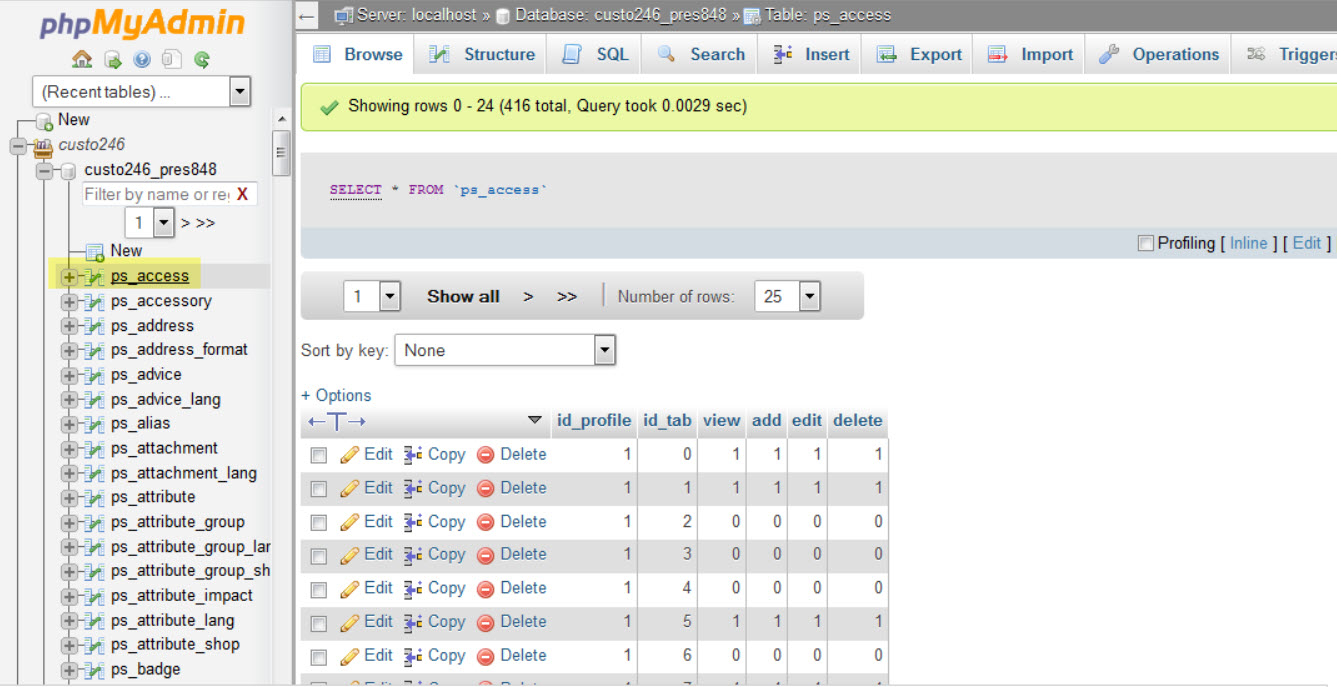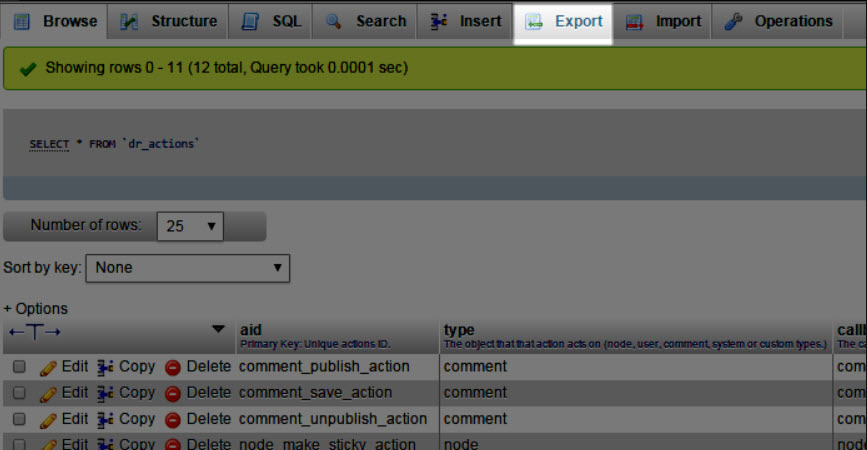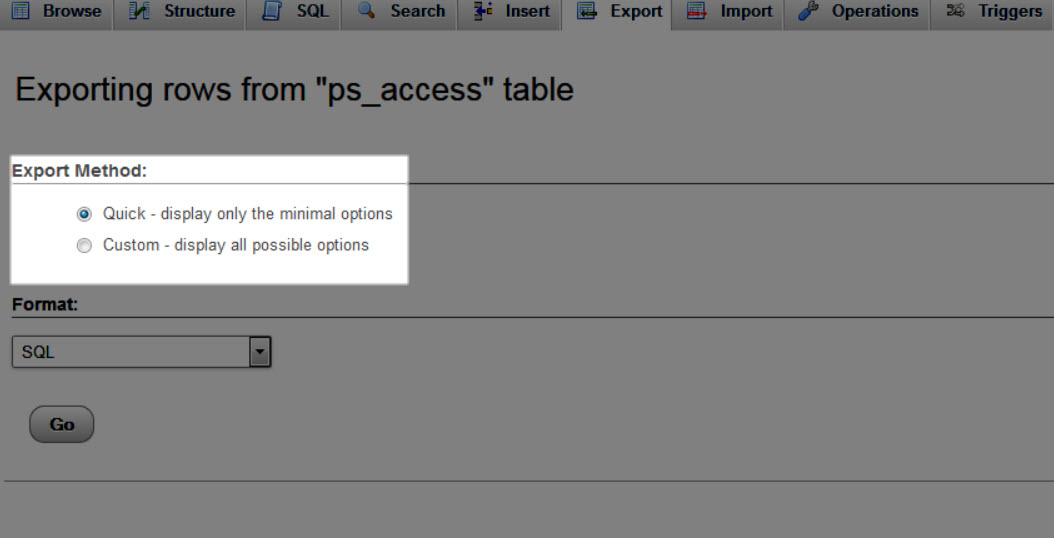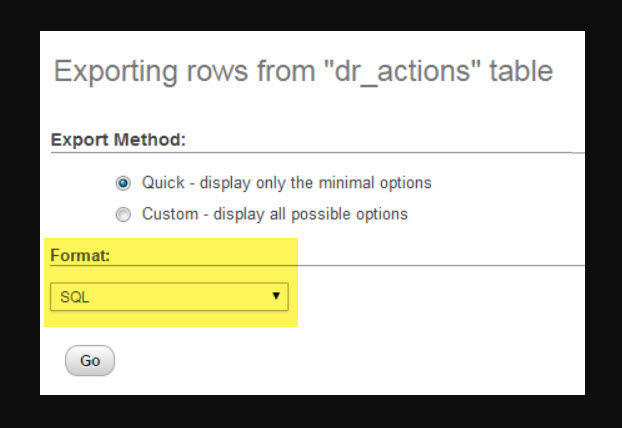- Import and export¶
- CSV¶
- CSV using LOAD DATA¶
- ESRI Shape File¶
- MediaWiki¶
- Open Document Spreadsheet (ODS)¶
- Table name¶
- Column names¶
- SQL¶
- XML¶
- Export¶
- CodeGen¶
- CSV¶
- CSV for Microsoft Excel¶
- Microsoft Word 2000¶
- JSON¶
- LaTeX¶
- MediaWiki¶
- OpenDocument Spreadsheet¶
- OpenDocument Text¶
- PDF¶
- PHP Array¶
- SQL¶
- Data Options¶
- Texy!¶
- XML¶
- YAML¶
- How to Export a Table in phpMyAdmin
- How to Export a MySQL Database Table
Import and export¶
To import data, go to the “Import” tab in phpMyAdmin. To import data into a specific database or table, open the database or table before going to the “Import” tab.
In addition to the standard Import and Export tab, you can also import an SQL file directly by dragging and dropping it from your local file manager to the phpMyAdmin interface in your web browser.
If you are having troubles importing big files, please consult 1.16 I cannot upload big dump files (memory, HTTP or timeout problems). .
You can import using following methods:
You can specify an upload directory on your web server where phpMyAdmin is installed, after uploading your file into this directory you can select this file in the import dialog of phpMyAdmin, see $cfg[‘UploadDir’] .
phpMyAdmin can import from several various commonly used formats.
CSV¶
Comma separated values format which is often used by spreadsheets or various other programs for export/import.
When importing data into a table from a CSV file where the table has an ‘auto_increment’ field, make the ‘auto_increment’ value for each record in the CSV field to be ‘0’ (zero). This allows the ‘auto_increment’ field to populate correctly.
It is now possible to import a CSV file at the server or database level. Instead of having to create a table to import the CSV file into, a best-fit structure will be determined for you and the data imported into it, instead. All other features, requirements, and limitations are as before.
CSV using LOAD DATA¶
Similar to CSV, only using the internal MySQL parser and not the phpMyAdmin one.
ESRI Shape File¶
The ESRI shapefile or simply a shapefile is a popular geospatial vector data format for geographic information systems software. It is developed and regulated by Esri as a (mostly) open specification for data interoperability among Esri and other software products.
MediaWiki¶
MediaWiki files, which can be exported by phpMyAdmin (version 4.0 or later), can now also be imported. This is the format used by Wikipedia to display tables.
Open Document Spreadsheet (ODS)¶
OpenDocument workbooks containing one or more spreadsheets can now be directly imported.
When importing an ODS spreadsheet, the spreadsheet must be named in a specific way in order to make the import as simple as possible.
Table name¶
During import, phpMyAdmin uses the sheet name as the table name; you should rename the sheet in your spreadsheet program in order to match your existing table name (or the table you wish to create, though this is less of a concern since you could quickly rename the new table from the Operations tab).
Column names¶
You should also make the first row of your spreadsheet a header with the names of the columns (this can be accomplished by inserting a new row at the top of your spreadsheet). When on the Import screen, select the checkbox for “The first line of the file contains the table column names;” this way your newly imported data will go to the proper columns.
Formulas and calculations will NOT be evaluated, rather, their value from the most recent save will be loaded. Please ensure that all values in the spreadsheet are as needed before importing it.
SQL¶
SQL can be used to make any manipulation on data, it is also useful for restoring backed up data.
XML¶
XML files exported by phpMyAdmin (version 3.3.0 or later) can now be imported. Structures (databases, tables, views, triggers, etc.) and/or data will be created depending on the contents of the file.
The supported xml schemas are not yet documented in this wiki.
Export¶
phpMyAdmin can export into text files (even compressed) on your local disk (or a special the webserver $cfg[‘SaveDir’] folder) in various commonly used formats:
CodeGen¶
NHibernate file format. Planned versions: Java, Hibernate, PHP PDO, JSON, etc. So the preliminary name is codegen.
CSV¶
Comma separated values format which is often used by spreadsheets or various other programs for export/import.
CSV for Microsoft Excel¶
This is just preconfigured version of CSV export which can be imported into most English versions of Microsoft Excel. Some localised versions (like “Danish”) are expecting “;” instead of “,” as field separator.
Microsoft Word 2000¶
If you’re using Microsoft Word 2000 or newer (or compatible such as OpenOffice.org), you can use this export.
JSON¶
JSON (JavaScript Object Notation) is a lightweight data-interchange format. It is easy for humans to read and write and it is easy for machines to parse and generate.
Changed in version 4.7.0: The generated JSON structure has been changed in phpMyAdmin 4.7.0 to produce valid JSON data.
The generated JSON is list of objects with following attributes:
Type of given object, can be one of:
header Export header containing comment and phpMyAdmin version. database Start of a database marker, containing name of database. table Table data export. version ¶
Used in header type and indicates phpMyAdmin version.
Object name — either table or database based on type .
[ "comment": "Export to JSON plugin for PHPMyAdmin", "type": "header", "version": "4.7.0-dev" >, "name": "cars", "type": "database" >, "data": [ "car_id": "1", "description": "Green Chrysler 300", "make_id": "5", "mileage": "113688", "price": "13545.00", "transmission": "automatic", "yearmade": "2007" > ], "database": "cars", "name": "cars", "type": "table" >, "data": [ "make": "Chrysler", "make_id": "5" > ], "database": "cars", "name": "makes", "type": "table" > ]
LaTeX¶
If you want to embed table data or structure in LaTeX, this is right choice for you.
LaTeX is a typesetting system that is very suitable for producing scientific and mathematical documents of high typographical quality. It is also suitable for producing all sorts of other documents, from simple letters to complete books. LaTeX uses TeX as its formatting engine. Learn more about TeX and LaTeX on the Comprehensive TeX Archive Network also see the short description od TeX.
The output needs to be embedded into a LaTeX document before it can be rendered, for example in following document:
\documentclassarticle> \titlephpMyAdmin SQL output> \author<> \usepackagelongtable,lscape> \date<> \setlength\parindent>0pt> \usepackage[left=2cm,top=2cm,right=2cm,nohead,nofoot]geometry> \pdfpagewidth 210mm \pdfpageheight 297mm \begindocument> \maketitle % insert phpMyAdmin LaTeX Dump here \enddocument>
MediaWiki¶
Both tables and databases can be exported in the MediaWiki format, which is used by Wikipedia to display tables. It can export structure, data or both, including table names or headers.
OpenDocument Spreadsheet¶
Open standard for spreadsheet data, which is being widely adopted. Many recent spreadsheet programs, such as LibreOffice, OpenOffice, Microsoft Office or Google Docs can handle this format.
OpenDocument Text¶
New standard for text data which is being widely adopted. Most recent word processors (such as LibreOffice, OpenOffice, Microsoft Word, AbiWord or KWord) can handle this.
PDF¶
For presentation purposes, non editable PDF might be best choice for you.
PHP Array¶
You can generate a php file which will declare a multidimensional array with the contents of the selected table or database.
SQL¶
Export in SQL can be used to restore your database, thus it is useful for backing up.
The option ‘Maximal length of created query’ seems to be undocumented. But experiments has shown that it splits large extended INSERTS so each one is no bigger than the given number of bytes (or characters?). Thus when importing the file, for large tables you avoid the error “Got a packet bigger than ‘max_allowed_packet’ bytes”.
Data Options¶
Complete inserts adds the column names to the SQL dump. This parameter improves the readability and reliability of the dump. Adding the column names increases the size of the dump, but when combined with Extended inserts it’s negligible.
Extended inserts combines multiple rows of data into a single INSERT query. This will significantly decrease filesize for large SQL dumps, increases the INSERT speed when imported, and is generally recommended.
Texy!¶
Texy! markup format. You can see example on Texy! demo.
XML¶
Easily parsable export for use with custom scripts.
Changed in version 3.3.0: The XML schema used has changed as of version 3.3.0
YAML¶
YAML is a data serialization format which is both human readable and computationally powerful ( ).
© Copyright 2012 — 2021, The phpMyAdmin devel team Revision a90c7970 .
How to Export a Table in phpMyAdmin
phpMyAdmin is a powerful MySQL database client that has many capabilities. We will be showing one of its features – the export table option. Exporting a table means that you will make a copy of the table structures and its data. Caution should be taken whenever working with your database. Make sure that you make a current backup of your database before making any changes.
If you are exporting a table, you will be limited to 50 MB. Tables larger than 50 MB will require that you submit a ticket to technical support.
How to Export a MySQL Database Table
In the databases section, click on the icon labeled phpMyAdmin. This will launch the application and you will see the interface open with the list of databases that it can access listed on the left side.
Click on the plus sign (‘+’) next to the user name that appears in the column at left. This will expand the database list. Next, click on the plus sign (‘+’) next to the database that contains the table the you wish to export.
Click on the table name that you want to export.
In the top right of the phpMyAdmin interface, you should see a row of options starting with Browse. Click on Export in order to begin the export process.
In order to quickly export all of the data and the entire table structure, leave the Quick option selected. If you intend to be more selective, you would need to click on Custom in order to make changes to what will be exported. For the purposes of this tutorial, we will be exporting all of the table data, so please leave the option set to Quick.
The format of the exported file will be left as SQL. This can be changed by clicking on the drop-down arrow. However, to keep things simple, we are going to be using the default format of .SQL. Click on Go in order to start the export.
Depending on the size of the table, it may take some time for the export to occur. Also, your web browser will determine how the file will be handled and/or saved. For example, if the Downloads folder has been set in Firefox, then the exported file will be sent into that location. Other browsers may prompt you and ask for the location where the file should be saved. When the export completes, you will see the name of the file. Here’s an example of the text that you may see:
-- phpMyAdmin SQL Dump -- version 4.1.8 -- https://www.phpmyadmin.net -- -- Host: localhost -- Generation Time: Oct 21, 2014 at 10:12 AM -- Server version: 5.6.17-log -- PHP Version: 5.4.23 SET SQL_MODE = "NO_AUTO_VALUE_ON_ZERO"; SET time_zone = "+00:00"; -- Table structure for table `ps_access` -- CREATE TABLE IF NOT EXISTS `ps_access` ( `id_profile` int(10) unsigned NOT NULL, `id_tab` int(10) unsigned NOT NULL, `view` int(11) NOT NULL, `add` int(11) NOT NULL, `edit` int(11) NOT NULL, `delete` int(11) NOT NULL, PRIMARY KEY (`id_profile`,`id_tab`) ) ENGINE=InnoDB DEFAULT CHARSET=utf8; INSERT INTO `ps_access` (`id_profile`, `id_tab`, `view`, `add`, `edit`, `delete`) VALUES (1, 0, 1, 1, 1, 1), (1, 1, 1, 1, 1, 1), (1, 2, 0, 0, 0, 0), (1, 3, 0, 0, 0, 0), (1, 4, 0, 0, 0, 0), (1, 5, 1, 1, 1, 1), (1, 6, 0, 0, 0, 0), (1, 7, 1, 1, 1, 1), (1, 8, 0, 0, 0, 0), (1, 9, 1, 1, 1, 1),
The file that is exported in SQL format is actually a text file and you can open it to see its contents. If you need to find anything in particular, use your favorite text editor and use the search options to find the text/data that you require. Exported tables can be imported back into a database.




